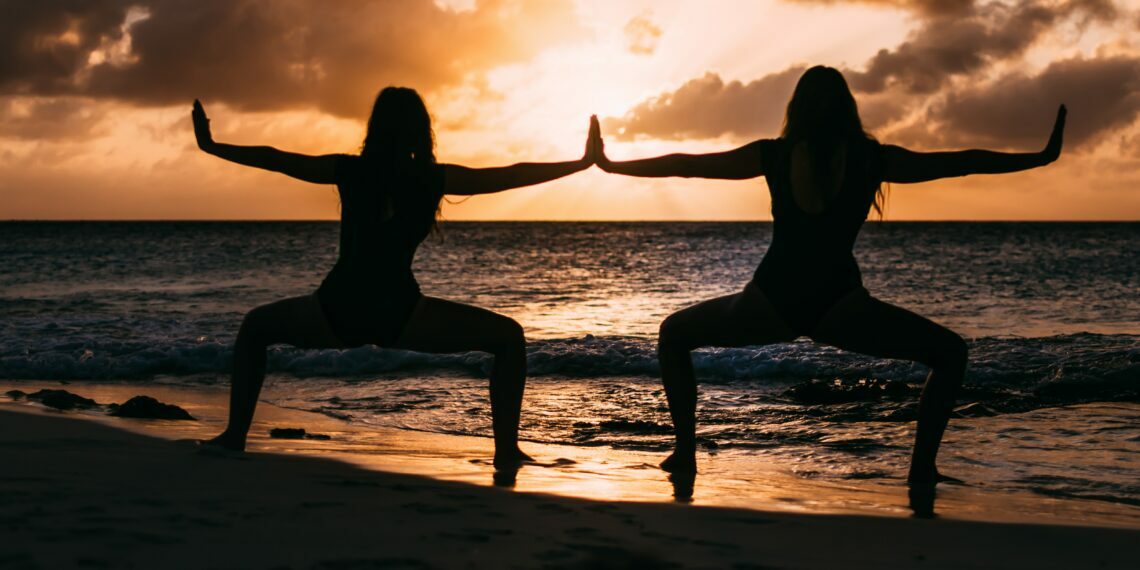Core Strengthening Asanas for a Better Posture
Asanas, or yoga poses, can be performed to stretch and relax, but also to strengthen your muscles. Weak muscles are one of the main reasons why so many people have lower back pain. By strengthening our core muscles,we can prevent and alleviate back pain, which thanks to our mostly sedentary lifestyle is a widespread ailment. Core strengthening asanas for a better posture will help you strengthen important muscles and so you can keep your body in correct posture.
Our Core Muscles Stabilize Our Whole Body
Core muscles include the muscles most responsible for posture, and because we find them at the center of the body. This big muscle group consist out of the following:
- pelvic floor muscles (pelvis diaphragma), responsible for your pelvic area and also supporting your pelvic organs
- transverse abdominal muscles (transverus abd.), which stretch horizontally across your whole abdominal wall on the left and the right side, which are needed for basically every movement you make
- external and internal oblique abdominal muscles (obliquus abd. Ext.et int.). The external abdominal oblique is located at the side and front of the abdomen, while the internal oblique abdominal muscles run under it in the opposite direction. They are responsible for rotation and compression of the torso.
- abdominal muscle (rectus abd.), the one that gives you the famous sixpack. It is responsible for flexing the lumbar spine and protecting your inner organs
- spinal tension muscles (erector sp.), a muscle group running in the back along the spine, responsible for straightening and rotating the back
- multifidus muscle, a thin muscle along the spine which is important for stabilizing it
- thoracic diaphragm, an internal skeletal muscle, which is important for breathing
Strengthening your core muscles is very important, because the correct posture stabilizes the joints. Many people with a sedentary lifestyle have a hunched posture and suffer from back and hip pain.By consciously training the core muscles, these problems can be solved and prevented.
How Yoga Helps Us Change in Everyday Life
It takes a lot of courage to be willing to look at ourselves and change our old patterns. Many people prefer the usual, the comfortable, rather than to feel uncomfortable. But by its very nature, change is inconvenient. When we change paths, we embark on a new path, we need commitment. This is especially true for a laborious and lengthy task as building up your core muscles.
This kind of inconvenient development is best practiced with holding yoga poses for a extended amount of time. In yoga, too, the path to development is perseverance. We can take this guideline as an analogy for our lives.
What happens on the spiritual or mental level mirrors what is happening on the physical one. We react emotionally and mentally to changes in our body, and can also physically feel tension, anger or joy.
On the physical plane, we choose to persevere asanas as an exercise, with the awareness that development and deepening will bear fruit. With the same attitude, we can be stronger in a more difficult emotional situation. So practicing core strengthening asanas with perseverance might not only strengthen your muscles, but also help you handle difficult life situations.
4 Core Strengthening Asanas for a Better Posture
The following core strengthening asanas for a better posture can be performed one after the other, with tuning and then relaxation at the end. It is a short flow, but you will alreahdy have done significant work for the improvement of your body and your mind.
Half Locust – Ardha Shalabhasana Variation 1
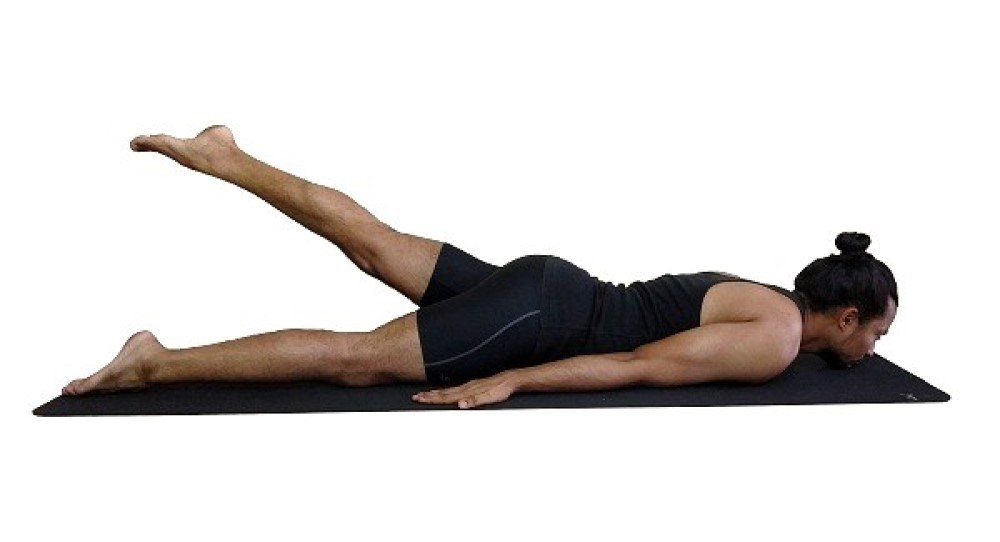
Start lying on your belly with your arms next to your thighs. The palms face downwards and the chin is on the ground, extending slightly forward and upward. Inhale while raising your right leg as high as possible with your toes pointing backwards, engaging your back and leg muscle. Your hips stay on the ground while you keep your torso in a neutral position.
Stay in this posture for 30 seconds, breathing normally. Try to keep your shoulders wide.
Exhale, lower your right leg. For the next inhalation, raise the left leg high and hold for the same 30 seconds, simultaneously with continuous natural breathing. This is repeated several times.
You can also exercise dynamically, following inhalation and exhalation cycles, raising one leg and then the other. The foot goes up for inhalation, it goes down for exhalation. Be sure to hold your breath for a long time and evenly.
Half Locust – Ardha Shalabhasana Variation 2
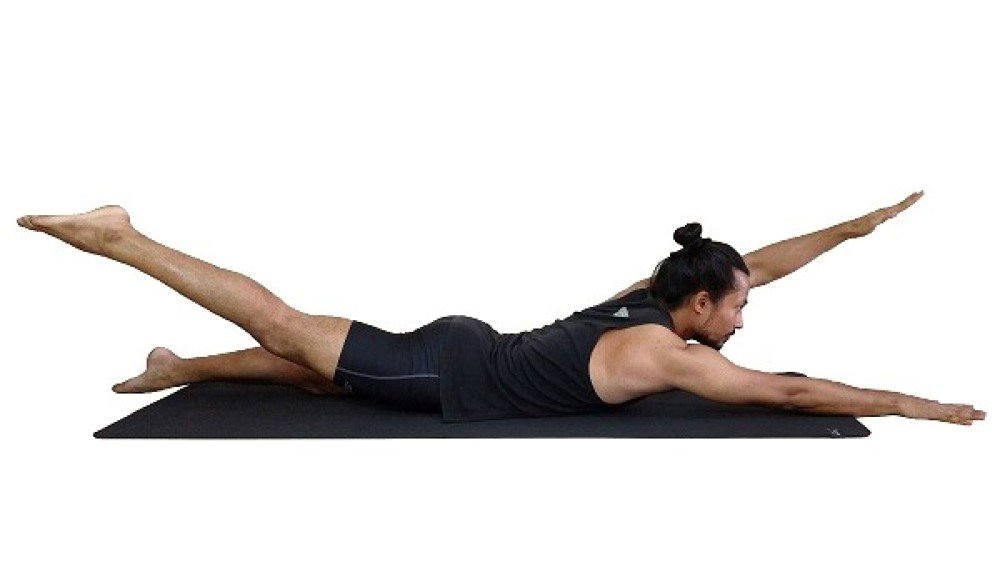
Lie on your stomach, head forward, arms outstretched. Keep both arms stretched in front of you and parallel. The legs are also stretched side by side. When inhaling, raise your left leg and right arm. Keep your head as high as possible. The toes point backwards, Stay in posture for 30 seconds, breathing normally. Exhale, lower your arm and feet, then repeat on the other side. Always raise the leg opposite to your raised arm.
Hold the pose for 30 seconds on one side and then on the other, or perform it dynamically, following the inspiratory (up) and exhale (down) cycles.
Benefits:
- Strengthens the lower back
- Massages the pelvic organs.
- Relieves tension in the pelvic area
- Tones the buttocks
Four-Point Plank, or “Plank” – Chaturanga Dandasana
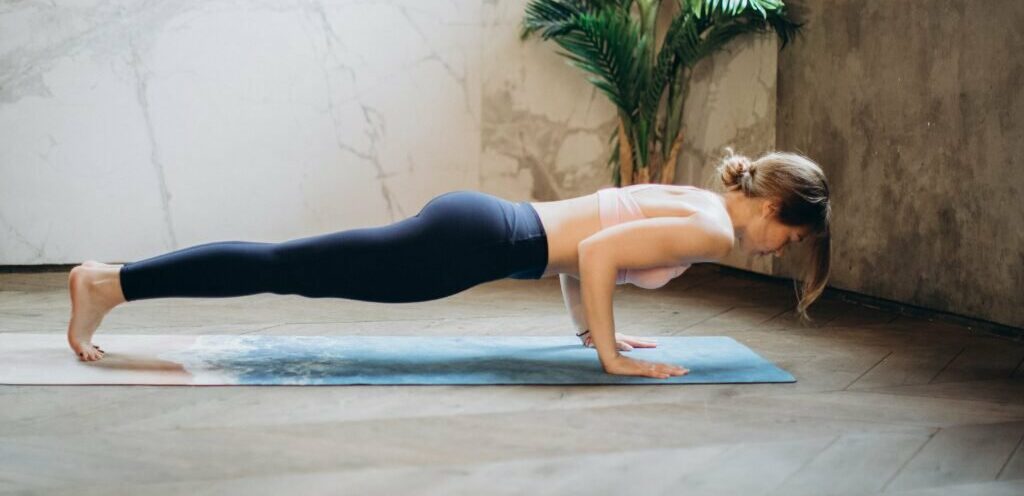
In Sanskrit, Chatu means four, Ranga means limb and Danda means tribe. This pose is also an essential part of the sun salutatios.
To start get into a normal plank on your toes with your arms stretched out and your body straight.
When you exhale slowly lower our upper body while keeping it straight, elbows next to the side of the body.
Stop when your elbow is in a 90-degree angle and stay in that position for about 30 seconds.
Tip for beginners:
If you don’t have the strength yet for this asana, you can do the same with your knees on the ground.
Benefits:
- Strengthens the arms and wrists
- Tones the abdominal muscles
- This pose is not recommended during pregnancy.
Boat Pose – Navasana
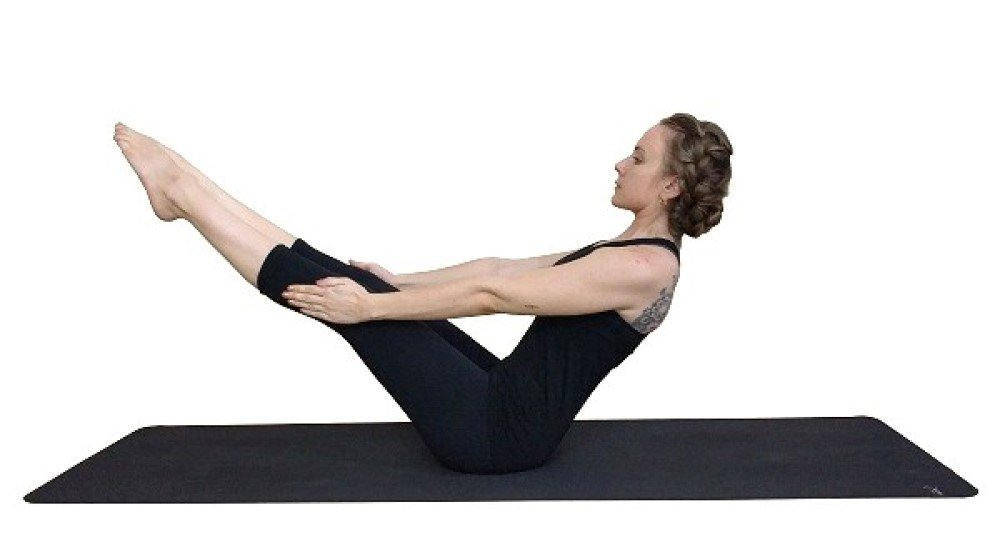
The balance in this posture comes from engaging your core muscles. Don’t let your chest sink, keep your back straight. Straight back, precise posture! This is one of the most effective core strengthening asanas.
Start with a sitting pose with a straight back and outstretched legs.
For inhalation, bend your knees so that the soles are on the floor. Keep your knees and legs together. Let your hands rest behind your hips on the ground. Straighten your back and pay attention to stretching your spine. Fold your shoulders back so that your chest is open.
Then connect the abdominal muscles to the pose and carefully start to pull your navel inwards towards the spine. Then from here, slowly lift your legs off the floor and try to straighten them. If it doesn’t go, then you can also do the pose with bent knees until the core muscles are strong enough.
Raise your hands, outstretched so that they are on both sides of the legs and parallel to the floor.
Fix your gaze to your toes. Breathe deeply and hold this pose for at least 30 seconds. To exit the posture, exhale, bend your knees and place your soles on the floor.
Tip for beginners:
If you can’t even hold the pose with bent knees, then you hold the back of your thighs with your arms, but your back always has to be straight!
Benefits:
- Relieves stress
- Strengthens central core muscles, abdomen and lower back.
- Stretches and strengthens the flexor and thigh muscles of the hips
- Stimulates the kidneys
- Improves digestion
- Improves balance
Practice These Asanas on a Daily Basis
The point is to keep the poses and get out of the hold so that it all happens with the awareness of breathing. If you may find it difficult to hold the pose, it is not necessary to give up, if we focus on breathing, we can strengthen our will and our muscles at the same time. These core amp asanas can be very helpful after a lot of sedentary work. That’s why it’s worth doing them on a daily basis! Do them at home or visit one of the best yoga studios in Budapest to practice with an experienced teacher.
Picture courtesy pranayoga.co.in.
 English
English magyar
magyar